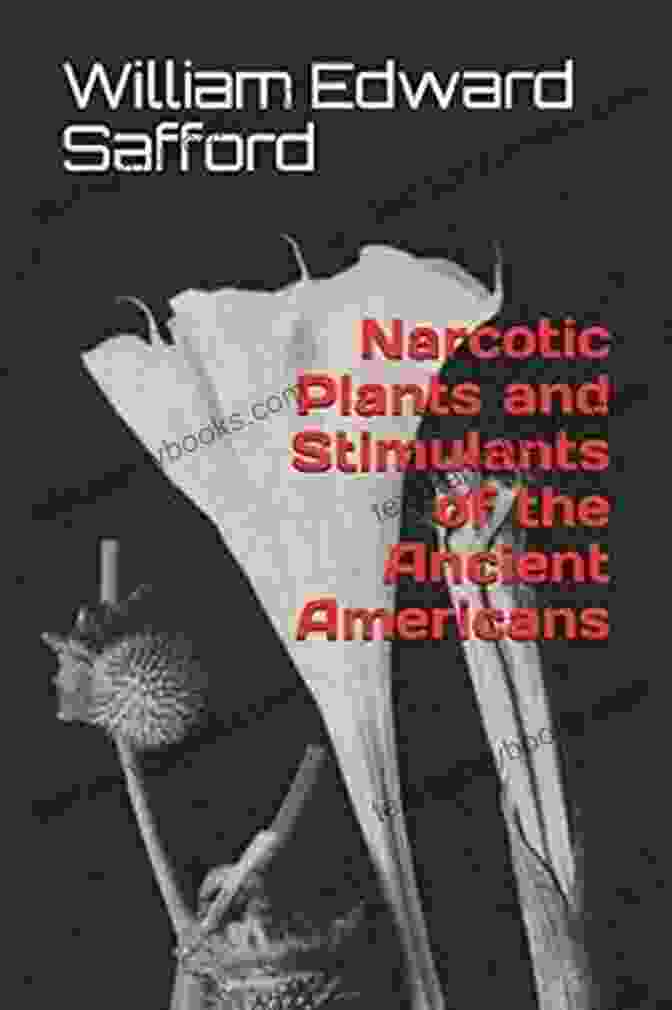Narcotic Plants and Stimulants of the Ancient Americans: Uncovering a Hidden History


The ancient Americans, stretching from the Arctic to the southern tip of South America, possessed a vast knowledge of the natural world, including the psychoactive properties of certain plants. This article delves into the captivating history of narcotic plants and stimulants used by these ancient cultures, revealing their cultural, religious, and medicinal significance.
4.6 out of 5
| Language | : | English |
| File size | : | 11809 KB |
| Text-to-Speech | : | Enabled |
| Screen Reader | : | Supported |
| Enhanced typesetting | : | Enabled |
| Print length | : | 100 pages |
| Lending | : | Enabled |
Tobacco: A Sacred Plant with Widespread Use
Tobacco (Nicotiana tabacum) was one of the most important plants for ancient Americans. Its use extended far beyond recreational purposes; it held deep spiritual and ceremonial significance. The Mayans, Aztecs, and Incas considered tobacco a sacred plant, believing it had the power to communicate with the gods. They used it in rituals and ceremonies, often in combination with other psychoactive substances.
Archaeological evidence suggests that tobacco use originated in South America around 6,000 years ago. It quickly spread throughout the Americas, becoming a staple plant for many tribes. The dried leaves were smoked in pipes, cigars, or rolled into cigarettes. Tobacco also had medicinal uses, including treating nausea, headaches, and toothaches.
Psychoactive Mushrooms: A Gateway to the Spirit World
Psychoactive mushrooms, known as "sacred mushrooms" or "magic mushrooms," played a significant role in ancient American spirituality. The most common species used were Psilocybe cubensis and Amanita muscaria.
These mushrooms were used in religious ceremonies and rituals, where they were believed to induce visions and provide a connection to the spirit world. The Aztecs called them "teonanácatl," meaning "flesh of the gods." They believed that consuming sacred mushrooms would allow them to communicate with the gods and receive divine guidance.
Peyote: A Visionary Cactus with Medicinal Benefits
Peyote (Lophophora williamsii) is a small, spineless cactus native to the southwestern United States and northern Mexico. Its psychoactive properties have been known to indigenous peoples for centuries.
Peyote was used primarily for religious and medicinal purposes. The Huichol Indians of Mexico considered it a sacred plant and used it in rituals to connect with their ancestors and communicate with the gods. They believed that consuming peyote could cure illnesses, promote healing, and bring good fortune.
Coca: A Stimulating Leaf with Controversy
Coca (Erythroxylum coca) is a shrub native to South America. The leaves contain a stimulant alkaloid called cocaine, which has been used by indigenous peoples for thousands of years.
The Incas prized the coca leaf for its ability to suppress hunger, fatigue, and altitude sickness. They consumed it by chewing the leaves directly or adding them to food and drinks. Coca was also used in religious ceremonies and was considered a sacred plant.
However, the controversial side of coca lies in the production of cocaine, a powerful and dangerous drug. The illicit cocaine trade has plagued South American countries for decades, leading to violence and exploitation.
Other Narcotic Plants and Stimulants
In addition to the plants discussed above, ancient Americans also used a variety of other narcotic plants and stimulants, including:
* Datura (Datura stramonium): A hallucinogenic plant with potent anticholinergic effects. * San Pedro cactus (Trichocereus peruvianus): A psychoactive cactus containing mescaline, a hallucinogen similar to LSD. * Yopo (Anadenanthera peregrina): A tree whose seeds contain a hallucinogenic alkaloid called bufotenin. * Ayahuasca (Banisteriopsis caapi): A vine containing dimethyltryptamine (DMT),a powerful hallucinogen.
The use of narcotic plants and stimulants by ancient Americans was deeply interwoven with their cultural practices, religious beliefs, and medicinal traditions. These plants served as tools for spiritual exploration, healing, and social bonding.
Today, many indigenous communities in the Americas continue to use these plants in traditional settings. However, the exploitation and illicit trade of some of these substances have raised concerns about their preservation and cultural significance.
Understanding the complex history of narcotic plants and stimulants among the ancient Americans provides valuable insights into their worldview and the enduring relationship between humans and psychoactive substances.
4.6 out of 5
| Language | : | English |
| File size | : | 11809 KB |
| Text-to-Speech | : | Enabled |
| Screen Reader | : | Supported |
| Enhanced typesetting | : | Enabled |
| Print length | : | 100 pages |
| Lending | : | Enabled |
Do you want to contribute by writing guest posts on this blog?
Please contact us and send us a resume of previous articles that you have written.
 Book
Book Novel
Novel Page
Page Chapter
Chapter Text
Text Story
Story Genre
Genre Reader
Reader Library
Library Paperback
Paperback E-book
E-book Magazine
Magazine Newspaper
Newspaper Paragraph
Paragraph Sentence
Sentence Bookmark
Bookmark Shelf
Shelf Glossary
Glossary Bibliography
Bibliography Foreword
Foreword Preface
Preface Synopsis
Synopsis Annotation
Annotation Footnote
Footnote Manuscript
Manuscript Scroll
Scroll Codex
Codex Tome
Tome Bestseller
Bestseller Classics
Classics Library card
Library card Narrative
Narrative Biography
Biography Autobiography
Autobiography Memoir
Memoir Reference
Reference Encyclopedia
Encyclopedia Meron Medzini
Meron Medzini Robert Byrne
Robert Byrne Mat Follas
Mat Follas Vernon P Davis Jr
Vernon P Davis Jr Mary Lee
Mary Lee Marya Hornbacher
Marya Hornbacher Roland Denzel
Roland Denzel Milton Steinberg
Milton Steinberg Meigyn Gabryelle
Meigyn Gabryelle Master Choa Kok Sui
Master Choa Kok Sui Mary Toscano
Mary Toscano Michael R Eades
Michael R Eades Neil J Gunther
Neil J Gunther Ron Kohavi
Ron Kohavi Mia K Markey
Mia K Markey Melinda Thompson
Melinda Thompson Riva Greenberg
Riva Greenberg Marla Heller
Marla Heller Roger K Young
Roger K Young Michael D Morgan
Michael D Morgan
Light bulbAdvertise smarter! Our strategic ad space ensures maximum exposure. Reserve your spot today!

 Nathaniel Hawthorne50 Treats For The Festive Season: Your Ultimate Guide to Holiday Baking
Nathaniel Hawthorne50 Treats For The Festive Season: Your Ultimate Guide to Holiday Baking
 Leo MitchellThe Complete Mediterranean Diet Cookbook For Beginners: Unlock the Culinary...
Leo MitchellThe Complete Mediterranean Diet Cookbook For Beginners: Unlock the Culinary...
 Michael CrichtonUnveiling the Extraordinary Journey of Satwant Kaur: Destined to Survive |...
Michael CrichtonUnveiling the Extraordinary Journey of Satwant Kaur: Destined to Survive |... Ralph TurnerFollow ·3.1k
Ralph TurnerFollow ·3.1k Brett SimmonsFollow ·10.9k
Brett SimmonsFollow ·10.9k Brady MitchellFollow ·3.2k
Brady MitchellFollow ·3.2k Winston HayesFollow ·15.4k
Winston HayesFollow ·15.4k Ted SimmonsFollow ·17.9k
Ted SimmonsFollow ·17.9k Andrew BellFollow ·13.8k
Andrew BellFollow ·13.8k Gavin MitchellFollow ·12.8k
Gavin MitchellFollow ·12.8k Dan BrownFollow ·16k
Dan BrownFollow ·16k

 Craig Blair
Craig BlairUnveiling the Power of 35 Phytochemicals: Nature's Secret...
1. Anthocyanins (blueberries, cherries,...

 Will Ward
Will WardNo Hot Sauce Tasting Journal: A Flavorful Journey for the...
Prepare your taste buds for an extraordinary...

 Dylan Hayes
Dylan HayesTo Cancer With Love: A Journey of Courage, Compassion,...
By Jane Doe When...

 Colton Carter
Colton CarterUnlock the Power of the Gut-Skin Connection: A Holistic...
Are you struggling with...

 Ian Powell
Ian PowellThe Art of Authentic Italian Pizza, Focaccia, and Sheet...
Rediscover the Flavors of...
4.6 out of 5
| Language | : | English |
| File size | : | 11809 KB |
| Text-to-Speech | : | Enabled |
| Screen Reader | : | Supported |
| Enhanced typesetting | : | Enabled |
| Print length | : | 100 pages |
| Lending | : | Enabled |








